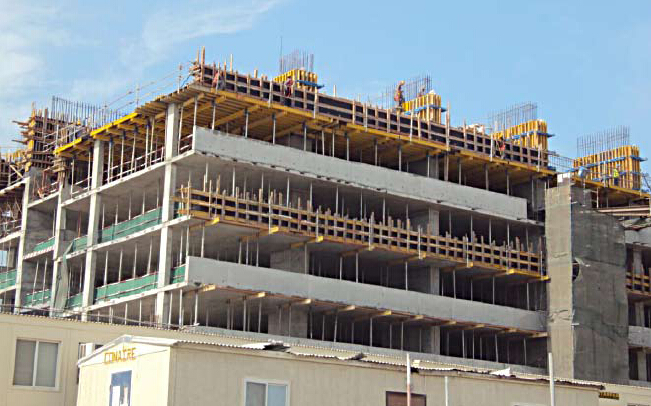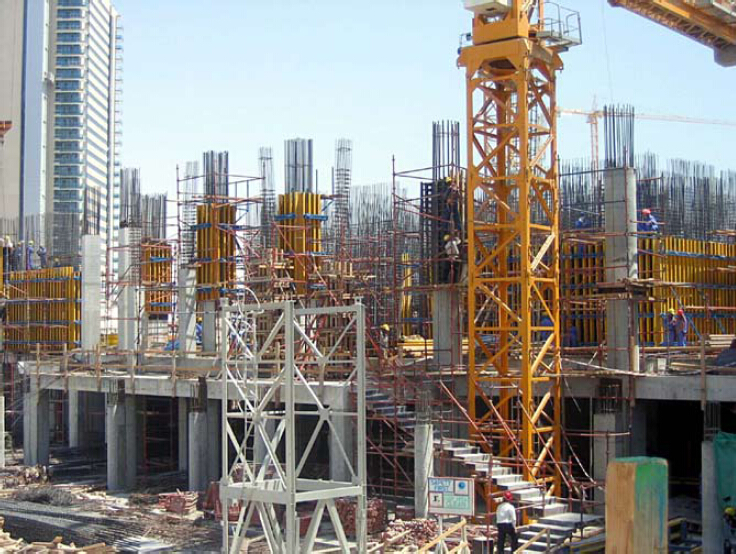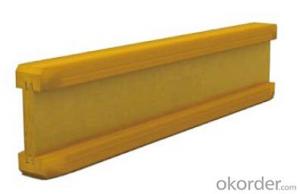Timber-Beam for formwork and scaffolding system
- Loading Port:
- Tianjin
- Payment Terms:
- TT OR LC
- Min Order Qty:
- 50 m²
- Supply Capability:
- 1000 m²/month
OKorder Service Pledge
OKorder Financial Service
You Might Also Like
Characteristics:
◆ Standardized production lines.
Supply capability: 3000m/day, Lmax = 6600mm.
◆ Finger jointing of the flange and web, the strength of timber beam is highly improved.
Max. shearing force failure load:40KN
◆ Well treated to prevent from water penetration or erosion, so the service life maximally extended.
Normally, CNBM timber beam H20 can be used for 4 to 5 years, the exact using time would depend on maintenance & storage.
◆ Robust caps at the end of the girders protect against damages.


- Q: How does steel formwork impact the overall cost of a construction project?
- Steel formwork can have a significant impact on the overall cost of a construction project. While steel formwork may have a higher initial cost compared to traditional timber formwork, it offers several advantages that can result in cost savings in the long run. Firstly, steel formwork is more durable and has a longer lifespan than timber formwork. It can withstand multiple uses without significant wear and tear, reducing the need for frequent replacements. This longevity of steel formwork eliminates the costs associated with purchasing new formwork materials for each construction project, resulting in long-term savings. Moreover, steel formwork provides superior strength and stability, allowing for larger and more complex construction designs. This enhanced structural integrity can reduce the need for additional support systems, such as props or scaffolding, which can add to the overall costs of a project. Additionally, steel formwork can be easily customized to fit different shapes and sizes, minimizing wastage and optimizing material usage. Furthermore, steel formwork offers faster assembly and dismantling times compared to timber formwork. The modular nature of steel formwork allows for easy installation and removal, reducing labor costs and increasing productivity. The shorter construction cycle facilitated by steel formwork can lead to significant time savings, enabling early project completion and reducing financing costs. Another cost-saving aspect of steel formwork is its reusability. Steel formwork can be dismantled, cleaned, and reused in subsequent projects, minimizing the need for new formwork materials. This not only reduces the material procurement costs but also decreases waste generation and environmental impact. However, it is important to note that the cost impact of steel formwork will vary depending on the specific project requirements and regional factors such as material availability and labor costs. Therefore, a detailed cost analysis considering all these factors is crucial in determining the overall cost-effectiveness of steel formwork for a construction project.
- Q: How does steel formwork perform in different weather conditions?
- Steel formwork performs well in different weather conditions. It is highly resistant to extreme temperatures, moisture, and UV radiation. This makes it suitable for use in both hot and cold climates. Steel formwork maintains its structural integrity and durability, ensuring consistent performance even in harsh weather conditions. Additionally, its non-absorbent nature prevents water damage or warping, making it a reliable choice for construction projects in various weather conditions.
- Q: Can steel formwork be used for curved structures?
- Yes, steel formwork can be used for curved structures. Steel is a versatile and strong material that can be easily shaped and fabricated to create various forms, including curved structures. With the help of advanced technologies such as computer-aided design (CAD) and computer-aided manufacturing (CAM), steel formwork can be custom-made to meet the specific requirements of curved structures. This allows for greater flexibility and creativity in architectural design, enabling engineers and architects to create unique and visually appealing curved structures. Additionally, steel formwork offers several advantages such as durability, reusability, and high load-bearing capacity, making it a suitable choice for constructing curved structures that require structural strength and stability.
- Q: How does steel formwork affect the overall thermal insulation of a structure?
- Steel formwork does not have a direct impact on the thermal insulation of a structure as it is primarily used for shaping and supporting concrete during construction. The primary purpose of steel formwork is to provide structural stability and shape to the concrete elements of a building, such as walls, slabs, and columns. The overall thermal insulation of a structure is mainly determined by other factors such as the type and thickness of insulation materials used, the design of the building envelope, and the presence of thermal bridges. Insulation materials such as foam boards, fiberglass, or mineral wool are typically installed within the walls, floors, and roofs to limit heat transfer through conduction, convection, and radiation. While steel formwork itself does not contribute significantly to thermal insulation, it can indirectly affect the insulation of a structure through its impact on the construction process. For instance, if the steel formwork is not properly sealed or installed, it can create gaps or voids in the concrete, which may allow heat to escape or enter the building. Additionally, if the formwork is not aligned accurately, it can affect the placement of insulation materials, resulting in thermal bridging and reduced overall insulation effectiveness. It is crucial to ensure that proper insulation measures are taken during the construction process, regardless of the type of formwork used. This includes ensuring that insulation materials are correctly installed without any gaps or thermal bridges and that the formwork is properly sealed to prevent air leakage. By addressing these aspects, the thermal insulation of the structure can be effectively maintained, regardless of the presence of steel formwork.
- Q: Can steel formwork be used for infrastructure construction projects?
- Indeed, infrastructure construction projects can make effective use of steel formwork. This option, known for its versatility and durability, proves ideal for a range of infrastructure types including bridges, tunnels, dams, and buildings. Given its strength and rigidity, it can withstand the heavy loads and high pressures commonly associated with such projects. Moreover, its easy dismantling and reusability factor into its cost-effectiveness and sustainability. As an added advantage, steel formwork offers flexibility for customization, enabling precise and accurate construction tailored to specific project requirements. Ultimately, steel formwork stands as a dependable and efficient solution for infrastructure construction projects.
- Q: How does steel formwork affect the overall flexibility of the construction process?
- The construction process can be significantly impacted by steel formwork, as it enhances overall flexibility. One of the main benefits of utilizing steel formwork is its exceptional strength and durability, which ensures the structural integrity of the formwork system while allowing for intricate and complex structures to be created. By employing steel formwork, there is greater flexibility in both design and construction. This enables the creation of more precise and accurate shapes, resulting in a higher level of architectural sophistication. Additionally, the ability to reuse the formwork multiple times reduces costs and increases efficiency in construction projects. Furthermore, the ease of assembly and disassembly of steel formwork leads to faster construction progress. This allows for shorter construction cycles, saving time and resources. The flexibility of steel formwork also permits adjustments and modifications during the construction process, facilitating adaptability to unforeseen changes or design revisions. Moreover, steel formwork provides enhanced safety and stability, ensuring a secure working environment for construction workers. Its high load-bearing capacity enables the construction of taller and more complex structures, expanding the possibilities in architectural design. Overall, the utilization of steel formwork enhances the flexibility of the construction process by enabling the construction of complex structures, offering design adaptability, reducing construction time, and improving safety. Its strength, durability, and reusability make it a preferred choice in the construction industry, leading to greater efficiency, accuracy, and innovation in building projects.
- Q: How does steel formwork handle different concrete surface protection methods?
- Steel formwork is highly versatile and can easily accommodate different concrete surface protection methods. It provides a strong and sturdy framework for the concrete, allowing for various surface protection techniques such as applying curing compounds, using membrane-forming curing compounds, or implementing surface retarders. Additionally, steel formwork can also withstand the pressure and temperature requirements of techniques like shotcrete or gunite application, further enhancing the concrete surface protection. Overall, steel formwork is compatible with a wide range of concrete surface protection methods, ensuring durable and high-quality results.
- Q: What are the different types of formwork corners used in steel formwork systems?
- Various types of formwork corners are utilized in steel formwork systems to create different shapes and angles during the construction process. These corners are specifically designed to offer stability, support, and flexibility when shaping concrete structures. The most common types of formwork corners used in steel formwork systems include the following: 1. External 90-Degree Corner: This particular corner is implemented to form a right angle or 90-degree corner in the formwork. It typically consists of interconnected and reinforced steel plates and angles to provide strength and stability. External 90-degree corners find frequent usage in constructing walls, columns, and beams. 2. Internal 90-Degree Corner: Similar to the external 90-degree corner, the internal 90-degree corner is employed to create a right angle or 90-degree corner in the formwork. However, it is designed to be placed within the formwork, resulting in a smooth finish on the exposed concrete surface. Internal 90-degree corners are commonly employed in walls, columns, and other structures where a clean finish is desired. 3. Adjustable Corner: When there is a requirement for various angles and shapes within the formwork, an adjustable corner comes into play. It comprises adjustable steel plates and angles that can be positioned and securely locked to achieve the desired shape and angle. Adjustable corners are versatile and can be utilized in curved walls, sloping structures, and irregular shapes. 4. Chamfered Corner: A chamfered corner is utilized to create a beveled or chamfered edge on the concrete structure. It typically consists of steel plates and angles that are positioned to form a specific angle or bevel. Chamfered corners are commonly employed in architectural applications to create decorative edges, enhance the structure's appearance, and facilitate a smooth transition between different elements. 5. Rounded Corner: A rounded corner is implemented to create a curved or rounded edge in the concrete structure. It is typically made of steel plates and angles that are bent or shaped to achieve the desired curve or radius. Rounded corners are frequently utilized in architectural applications, such as curved walls, arches, and other curved elements, to create visually appealing and unique designs. These examples represent only a few of the diverse types of formwork corners used in steel formwork systems. The selection of a specific corner type hinges on the desired shape, angle, and finish of the concrete structure being formed. It is crucial to choose the appropriate formwork corner to ensure the integrity and quality of the construction project.
- Q: How does steel formwork handle formwork stability during concrete pouring?
- Steel formwork provides excellent formwork stability during concrete pouring due to its high strength and rigidity. It can withstand the pressure and weight of the fresh concrete without deformation or collapse, ensuring the desired shape and structure of the concrete elements. Additionally, steel formwork can be easily adjusted and secured in place, allowing for precise alignment and stability during the pouring process.
- Q: What are the typical lead times for manufacturing and delivering steel formwork?
- The typical lead times for manufacturing and delivering steel formwork can vary depending on factors such as the complexity of the design, quantity required, and the current workload of the manufacturer. However, on average, it usually takes around 4-6 weeks for the manufacturing process, while the delivery time can range from a few days to a couple of weeks depending on the location and transportation arrangements.
Send your message to us
Timber-Beam for formwork and scaffolding system
- Loading Port:
- Tianjin
- Payment Terms:
- TT OR LC
- Min Order Qty:
- 50 m²
- Supply Capability:
- 1000 m²/month
OKorder Service Pledge
OKorder Financial Service
Similar products
Hot products
Hot Searches
Related keywords





















